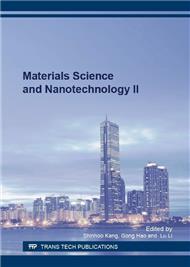p.3
p.8
p.14
p.19
p.23
p.31
p.40
p.45
Effect of Hafnium on the Structural and Mechanical Properties of the Surface Layers on the Basis of TiNi
Abstract:
The study contains a complex method of forming the surface-modified layers using materials with shape memory effect by high-speed gas-flame spraying of mechanically activated powders based on TiNiHf, followed by thermal and thermomechanical treatment. This allowed us to form the nanoscale state in the surface layers, which have high levels of functional, mechanical and performance properties. We demonstrated that pre-mechanoactivation of TiNiHf powder has reduced the coatings' porosity (less than 1%) and provided adhesive strength of the coating with the substrate (110 to 120 MPa). We described the formation mechanism of nanostructured state in TiNiHf powders under severe plastic deformation during mechanical activation, comprising the steps of high-speed deformation, polygonization and recrystallization.
Info:
Periodical:
Pages:
8-13
Citation:
Online since:
August 2016
Authors:
Keywords:
Price:
Сopyright:
© 2016 Trans Tech Publications Ltd. All Rights Reserved
Share:
Citation:


